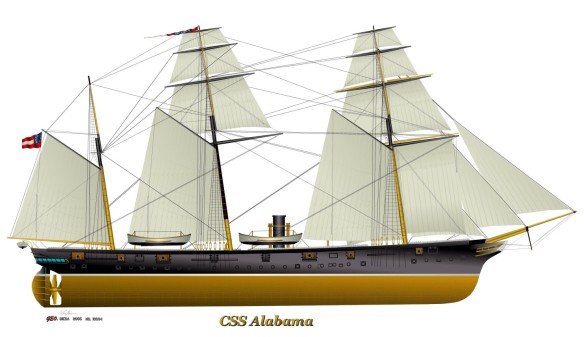CSS Alabama
The end of the period of the sailing men-of-war was not suddenly apparent,” noted the maritime historian Howard I. Chapelle, “nor was it marked by a dramatic flourish.” During the three decades after the wars of the French Revolution and Empire, the refinement of the sailing warship continued, reaching its apogee in the late 1840s. Except for their rounded sterns, the new ships looked much like their predecessors, although they were larger, more strongly built, and more heavily armed. But as designers, shipwrights, and carpenters crafted ships that were veritable works of art, the products of the technicians of the industrial revolution slowly penetrated the “wooden world.” Even as Lord Nelson stood watch off Toulon and Cadiz, steam-powered boats plied some of the major rivers of England and America, while men such as Robert Fulton envisioned steam-powered men-of-war. During the War of 1812 the Americans began construction on the Demologos, a steam-powered, 2,475-ton, 30-gun, 156-foot frigate designed by Fulton with the vulnerable paddle wheel placed for safety in the middle of the ship’s catamaran-like hull. The war ended before the Demologos, rechristened the Fulton after the designer’s death, saw action. In the late 1820s steam-powered dispatch boats entered the British naval service. In the 1830s the French and the Greeks were the first to use steam-driven warships in combat, often armed with the new explosive-shell guns designed by Major Henri-Joseph Paixhans. In the 1840s the Royal Navy employed gunboats powered by steam, such as the infamous 600-ton Nemesis, armed with a pair of 32- pounder pivot guns, to deadly effect in Asian waters.
Also during the 1840s, the adoption by the world’s major navies of the Swedish inventor John Ericsson’s screw propeller accelerated the shift to steam. “The sailing warship might have survived longer had she been required to compete only with side-paddle steamers,” Chapelle concluded, “but the appearance of the screw propeller made the auxiliary steamer practical and hastened the end of the sailing ship.” By the late 1840s and early 1850s even the largest warships—frigates and ships of the line—relied on steam power as an auxiliary, and in combat the principal, source of propulsion.
The impact of the industrial revolution on navies was by no means limited to propulsion. Warships were, after all, nothing but platforms for weapons, principally cannon, designed to destroy an enemy’s ships or to batter masonry or earthen forts into submission. After the defeat of Napoleon I there began an unending and ultimately unwinnable race between gun and armor, a race that could be run only because of the availability of the steam engine to power more heavily armed ships. In the 1820s advanced industrial and metallurgical techniques allowed the casting of much larger, though still muzzle-loading, guns, their killing power enhanced by a more scientific approach to sighting. Simultaneously the French developed the “Paixhans” explosive-shell gun that threatened to turn wooden ships into combustible piles of splinters. Although the successes of the Paixhans gun in the Greek war for independence, the Crimean War, and the French intervention in Mexico were exaggerated by many contemporaries, mid-century advances in firepower prompted navies to “clad” their wooden ships with plates of iron. The French launched their first armored steam warship—the 13-knot la Gloire—in 1859. The British countered in 1861 with the Warrior, an iron-hulled, 400-foot man-of-war capable of 14 knots mounting thirty-eight 68- pounder naval guns.
During the American Civil War, the navies of the North and the South reflected the revolutionary changes overtaking naval establishments. The Federal navy continued to employ numerous wooden sailing men-of-war outfitted with auxiliary steam power. The infamous Confederate raiders, such as the Alabama, likewise relied on their sails for cruising and used steam as a combat auxiliary. The principal armament of these raiders and the ships that hunted them was massive, centrally mounted, rifled pivot guns capable of firing to port or starboard. For coastal defense the South clad many of its wooden ships, such as the Virginia, with iron and dispensed with sails. The North countered with its own ironclads as well as several classes of iron-constructed and -armored “monitors” mounting heavy muzzle-loading cannon in powered turrets.
This contest between the gun and armor placed a premium on penetration rather than explosive power. To defeat armor, navies adopted ever larger rifled cannon capable of hurling shot, increasingly designed to pierce armor plate, with greater range, accuracy, and penetrating ability. Rifling, in turn, led to longer barrels, which promoted a shift to breechloading mechanisms in the 1860s.
As a result of these changes, during the decade after the American Civil War the “modern” warship began to emerge. In 1872 the Italians launched the Duilio, with armored decks and turrets set in echelon. The following year the British commissioned the Devastation, the man-of-war that established the “pattern for the future development of the battleship so decisively that even the revolutionary and famous Dreadnought of 1906 was only a final extension of the principles which she embodied.” By the end of the century, the lines of the “modern” battleship were clearly recognizable: steel construction, compartmentalization, steam power, substantial armoring, and heavy breech-loading rifled main guns supported by lighter but more quickly firing weapons.
As engagement ranges increased, sighting the arched fire of myriad naval guns became next to impossible. The chaotic patterns of splashes made the correction of individually sighted guns impractical. The solution involved controlled salvo firing by batteries of uniform type and led to the introduction of the first all-big-gun battleships, the most famous of which was the Royal Navy’s Dreadnought, launched in February 1906. The 17,900-ton ship mounted ten 12-inch guns in her main battery and was the first man-of-war powered by steam turbines. Thereafter battleships became larger, faster, and more heavily armed, but the Dreadnought pattern remained unchanged for another forty years.
